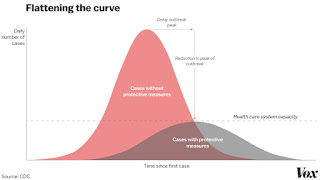On Thursday, March 26, the United States took over the top
spot for the number of reported COVID-19 cases, exceeding 85,000. It’s
important to recognize that reported cases are an inaccurate proxy for
actual cases. Some countries may deliberately under-report their rate of
infection. Some countries do more testing than others. Regardless of the
statistic’s flaws, it’s what we have available.
Being number one is not a status we’d prefer, but it’s one
we are likely to keep for a time. Ultimately, India, with its population four
times larger than ours, or Indonesia, Brazil, Pakistan, Nigeria, Bangladesh or
similar with lesser populations but less-developed healthcare could exceed our overall
cases. We don’t wish it on anyone.
Using Reported Cases per Million of Population
Because of the population differences, the raw number of
cases does not reflect the status of the disease within a country. Ten-thousand
cases in a country of ten million is much more serious than ten thousand cases
in a country of one-hundred million. Converting the raw reported numbers into cases
per million of population eliminates the effect of population size.
All statistics used in this blog come from https://www.worldometers.info/coronavirus/.
I have not attempted to independently verify their numbers, but I believe them
to be reliable. As of March 26, the U.S. had a reported case rate of 258 per
million. Italy stood at 1,333; Spain at 1,236, Germany at 524. Some countries
we don’t hear about in the news have much higher rates: Iceland stands at 2,350
and Luxembourg at 2,321.
The U.S. Prognosis if it follows other country trends.
We are in the early stages of this
contagion’s spread. I prepared this chart to illustrate how our rate of
reported cases compares with Italy and Germany. Day 1 for each country is the
date when reported cases per million of population was approximately 6. Italy (in
blue) reached that milestone first and, therefore, has the most days on the
chart. Germany (salmon) reached the threshold eight days after Italy. The U.S. (black) had
the benefit of an additional week before it crossed the threshold.
Germany has closely tracked Italy for three weeks. That does not mean we know Germany will continue to follow Italy’s trend. Perhaps their “social distancing” measures will prove more effective, or their healthcare system more robust in stopping the spread of the disease by better testing and isolation of patients with positive coronavirus results.
The United States can take no comfort from this chart. Our
rate of increase for the last week has exceeded Italy’s and Germany’s for their
equivalent period.
What would it mean if we were to follow Italy’s trajectory?
Using their 1,333 cases per million, the U.S. would total 440,000 reported
cases at day 30. We would have about 33,000 new cases that day—Good Friday—two
days before the President wishes for filled churches on Easter Sunday.
Will it be that bad?
I have no idea. Perhaps the measures many states have taken
will be much more effective than Italy’s efforts, and we’ll see our rate of
infection slow significantly. But it is also possible that because of the
independent spirit Americans are so proud of, large pockets of the country will
continue to ignore best medical precautions and our path will continue to
worsen.
Below is the same chart, but with Spain
added.
Spain (green) reached the initial six cases per million on the same day as Germany. They did not implement the same precautions, and Spain’s rate per million has already exceeded Italy’s.
These charts should be a precautionary tale. In the U.S. we
still have large portions of our population who continue to be exposed. Those
working in our hospitals are most vulnerable: we bring the worst cases to them.
That is the sharp tip, but underneath are all those who continue to serve so we
may live. The folks at the grocery stores, drug stores, Amazon’s warehouses,
factories producing masks and ventilators, police, fire, national guard. The
list goes on.
We have not isolated those “out in the world” from those in
“self-isolation.” That’s why infections are likely to continue for many more
weeks. We can hope warm weather will help bring an end, but seeing cases rising
in places like Australia and Chile, where summer recently moved to autumn, do
not provide comfort.
Over the next days, facts will replace supposition
concerning the trajectory of infections in the U.S. Rather than wishing and
hoping for life to return to normal in two weeks, we need to concentrate on caring
for those most ill and protecting those most vulnerable from contact with
anyone infected.
This might be an appropriate time to live the words John F
Kennedy used in his inaugural speech. “Ask not what your country can do for
you; ask what you can do for your country.”
* * * * *
* * * * *
James
M. Jackson authors the Seamus McCree series. Full of mystery and suspense,
these thrillers explore financial crimes, family relationships, and what
happens when they mix. False Bottom,
the sixth and most recent novel in the series is set in the Boston
area. You can sign
up for his newsletter and find more information about Jim
and his books at https://jamesmjackson.com.


